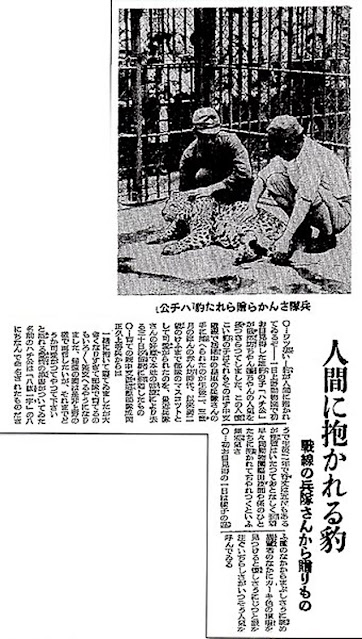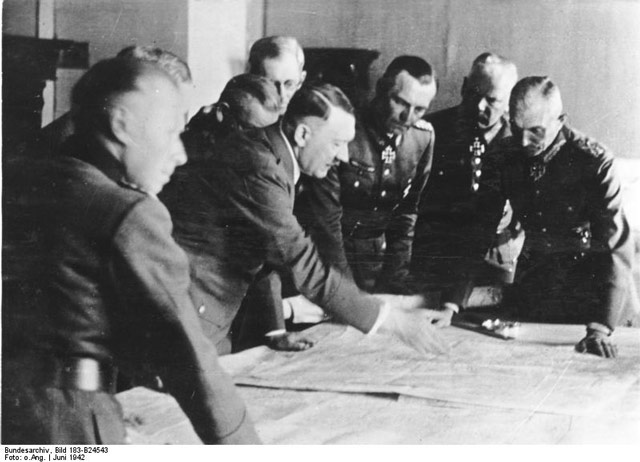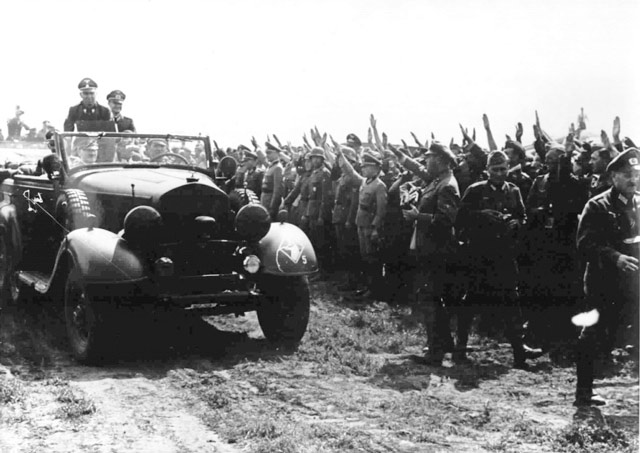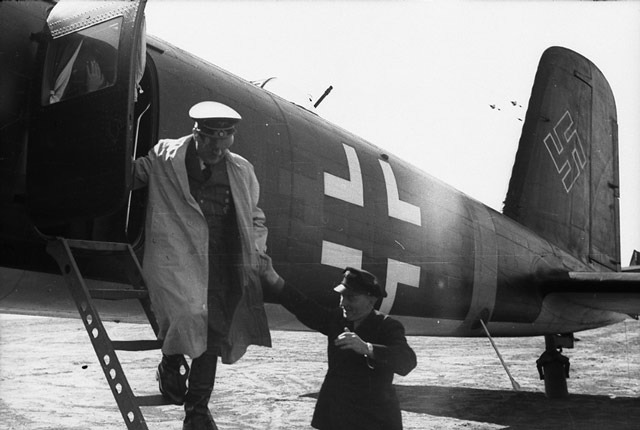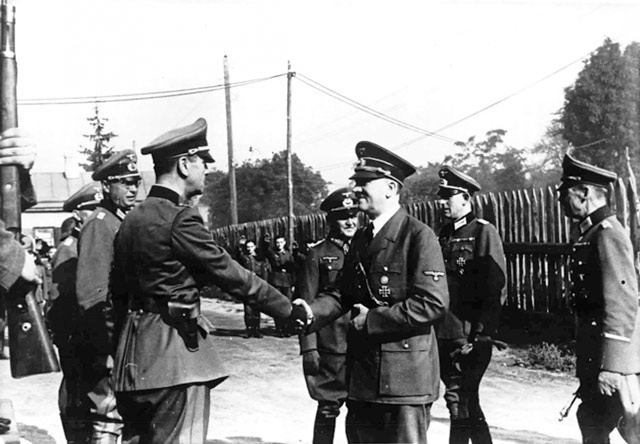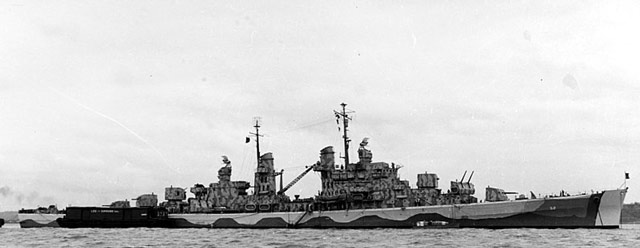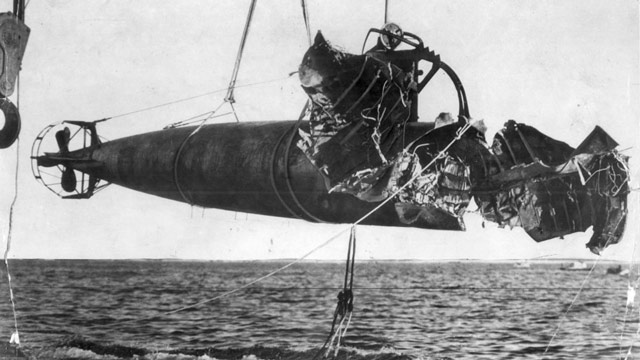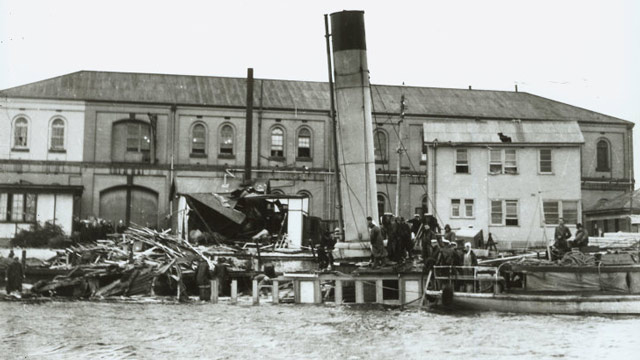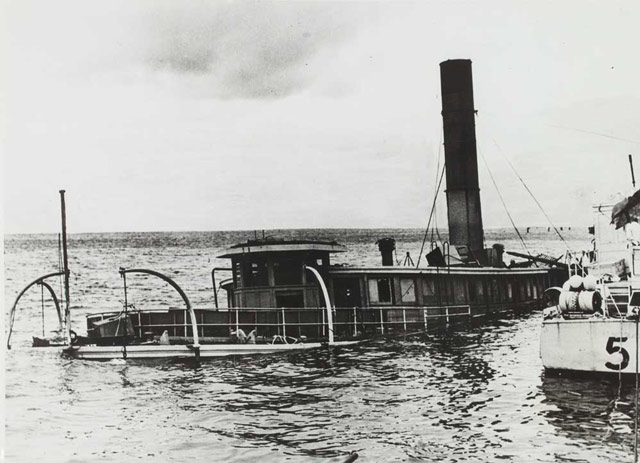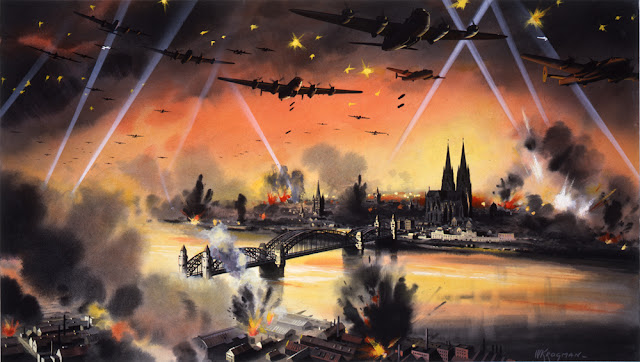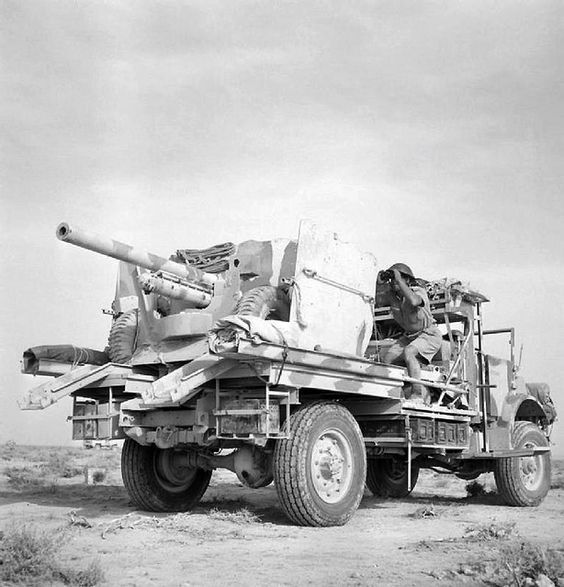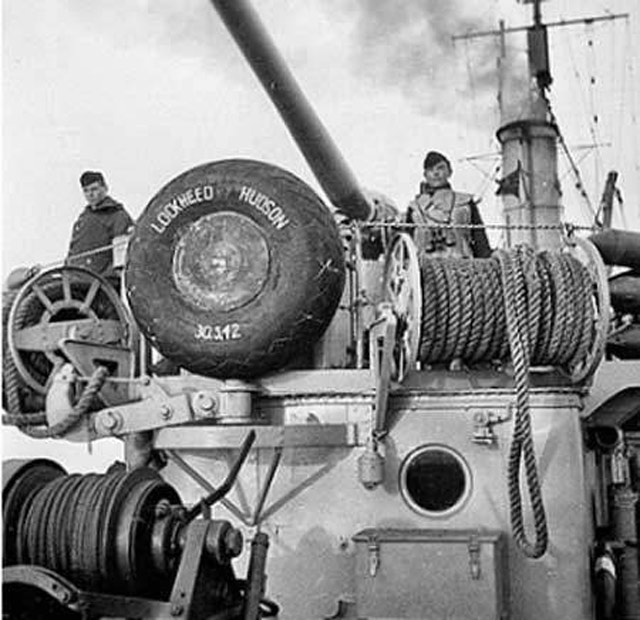Tuesday June 2 1942
 | |
| "An infantryman takes the surrender of the crew of an enemy supply truck in the Western Desert, 2 June 1942." © IWM E 12810. |
Battle of the Pacific: About 350 miles (648 km) northeast of Midway Island, US Navy Task Force 16 (carriers USS Enterprise (CV-6) and Hornet (CV-8)) joins with Task Force 17 (Yorktown (CV-5)) on 2 June 1942. Rear Admiral Frank Jack Fletcher aboard Yorktown assumes tactical command of the entire force, with Rear Admiral Raymond A. Spruance in charge of TF16.
Altogether, the three US carriers carry 234 aircraft. There also are 110 fighters, bombers (including B-17s, though six of the sixteen there are sent back to Hawaii today), and patrol planes on Midway itself, giving the US a slight numerical advantage in planes over the approaching Japanese fleet. In the waters nearby are 25 US Navy submarines. Only a few key officers on Midway know of the presence of the US carriers. The Navy pilots stationed on Midway are told not to "expect any help from the U.S. carriers; they’re off defending Hawaii."
The 11th Air Force in Alaska has been moving assets toward the Aleutian Islands in preparation for an expected Japanese invasion. Today, two PBY-5A Catalinas of the USN's Patrol Squadron Forty One (VP-41) flying out of Dutch Harbor spot the incoming invasion force. They report Japanese aircraft carriers HIJMS Ryujo and Junyo about 210 miles (644 km) away from Dutch Harbor. The Japanese on the carriers also spot the PBYs, and Zeros quickly shoot them down. One crewman is taken prisoner while the rest on the two planes perish.
Admiral Kakuta in command of the two Japanese light carriers is preparing to raid Dutch Harbor, which is now alerted. However, this is only a feint, as the invasion force is heading for islands further west in the Aleutians.
Fifth Air Force raids the Japanese base at Rabaul.
Japanese 5822-ton freighter Kofuku Maru hits a mine and sinks off Rangoon, Burma.
 |
| The U.S. Navy escort carrier USS Long Island (AVG-1) moored at Naval Air Station North Island, California (USA), on 2 June 1942, shortly before she sortied with Task Force 1 (TF-1) under Vice Admiral William S. Pye. Aircraft on deck include six Grumman F4F-4 Wildcat and three Curtiss SOC-3A Seagull of Auxiliary Scouting Squadron 1 (VGS-1). Naval History and Heritage Command 80-G-31839. |
Battle of the Indian Ocean: The two Japanese survivors of the attack on Sydney Harbour on 30 May 1942, Lt Akieda Saburo and PO1C Takemoto Masami, have traveled 48 miles on foot when they are intercepted and killed in a gunfight with Royal Marines Commando No. 5 at Amponkarana Bay. One Marine also is killed and four more wounded by a sword wielded by one of the Japanese. The two fleeing men were betrayed by a local in a village where they stopped to get food. I-20, submerged off Amber Bay, will wait for another 36 hours before giving up hope of picking up any of the men.
Eastern Front: Harko (Hoeheres Artillerie Kommando) 306, Eleventh Army's artillery command, gives the order today to open fire on the Red Army's Sevastopol defense with everything. And by everything, they mean everything.
This includes 17-inch (420mm) GAMMA, known to the world as "Big Bertha" during World War I, and 21-inch KARL. The biggest gun of all, though, is DORA, a 31.5-inch (800mm) artillery weapon that fires a 7-ton shell and can penetrate 90 inches of steel. It has taken a month, a crane, and thousands of soldiers to get DORA ready. These artillery weapons are massive and extremely vulnerable to air attack, but they can be deployed because the Luftwaffe has complete control of the skies over Crimea. It is a one-off situation where there is no fear of retaliation and the biggest weapons ever made can just fire as many rounds as they are able (which isn't that many per day due to technical issues).
 |
| DORA finally ready to fire. |
The firing of 600 large artillery pieces (1300 total) controlled by Harko 306 is joined by air attacks by VIII Air Corps, concentrating on Soviet forts to the north of the port. Luftwaffe General von Richtofen awakens at 03:30 and at daybreak flies over the cloudless combat zone in his personal Fieseler Storch observation plane. He is aloft when the artillery opens fire.
VIII Air Corps has been greatly reinforced by stripping South Air Corps based in Kerch. Its planes fly from airfields at Saki, Sarabus, and Simferopol, all within 70 km of the port. The planes arrive for their first sortie of the day between 06:00 and 06:30. The area of bombardment is scheduled to shift from one area to another each day to soften up the entire Red Army line. Today's area of attack is against barracks northeast of the city and mobilization points in the villages of Schabykina and Balossowa to the southeast. At 07:00, a full attack using everything in the arsenal begins and lasts for twelve hours. All told, the Luftwaffe flies 723 sorties today and drops 525 tons of high explosives while shooting down six enemy planes. The Red Army pilots are completely outmatched, and four of their planes are shot down while they are trying to flee from Crimea to airfields in the Caucasus. The Germans only lose one Junkers Ju 87 Stuka.
DORA does not have to make many direct hits to achieve results, because every single one that does hit the target completely destroys the pillbox or fort. At Fuhrer Headquarters, General Franz Halder simply notes in his war diary, "Artillery assault of Sevastopol has started... On the whole, a day without important events or changes on the front."
While it is a quiet day at Fuhrer headquarters, Halder does have several meetings today. One of them is with Major Count Stauffenberg. They discuss issues with the troops that just won the victory southeast of Kharkov near Izyum, which includes a disturbing shortage of horses in a place where the great summer offensive is to be launched within a few weeks.
 |
| "Aerial photograph of Beaulieu airfield, looking north 2 June 1942. Photograph taken by No. 1 Photographic Reconnaissance Unit, sortie number RAF/HLA/567. English Heritage (RAF Photography)." American Air Museum in Britain. |
European Air Operations: It is a fairly quiet day on the Channel Front at first as both sides recuperate from their recent bombing missions (RAF Bomber Command to Cologne and Essen, the Luftwaffe to Canterbury). At first light, there are RAF patrols along the French coast between Gravelines and Dunkirk at 20-25,000 feet without incident. A second sweep at 09:30, however, turns into a massive dogfight over Le Touquet, where the Luftwaffe has an airbase. RAF No. 403 Squadron finds itself facing 40-50 enemy Focke Wulf 190s. The Allies (Canadians) lose six out of twelve pilots. The Luftwaffe also loses planes but seems to have gotten the better of the encounter. In a sign of the resiliency of the RAF, the six lost planes are replaced by nine new Spitfires by dinner time.
Battle of the Atlantic: In one of the more unusual events of the Battle of the Atlantic, U-213 (Oblt. Amelung von Varendorff), on its second patrol out of Lorient, spots 6826-ton Norwegian freighter Berganger southeast of Cape Cod at 03:32. Varendorff has bad luck, however, and all five torpedoes that he fires miss. However, the freighter also has very bad luck, as during the evening U-578 (KrvKpt. Ernst-August Rehwinkel), on its fourth patrol out of St. Nazaire, also spots the freighter and pumps a torpedo into the ship at 20:27. Rehwinkel then pumps a coup de grâce into the freighter, whose gunners have begun firing at his submarine. After the ship sinks Rehwinkel surfaces, questions the survivors, and takes pictures of them. There are 4 dead and 43 survivors, who occupy three lifeboats and are rescued by several different ships on 4 June.
U-156 (Kptlt. Werner Hartenstein), on its third patrol out of Lorient, torpedoes 5970-ton Brazilian freighter Alegrete between St. Lucia and St. Vincent. All 64 aboard the ship survive. This sinking is sometimes listed as happening on 1 June because it happens right around midnight on 1 June, so I mention it on both dates.
U-158 (Kptlt. Erwin Rostin), on its second patrol out of Lorient, torpedoes and sinks 5686-ton US freighter Knoxville City 50 miles southeast of Cape Corrientes, Cuba. There are two dead and 53 survivors. This sinking also is sometimes listed as occurring on 1 June 1942.
U-159 (Kptlt. Helmut Friedrich Witte), on its second patrol out of Lorient, sports 5403-ton U.S. transport Illinois 400 miles northwest of Puerto Rico. Witte hits the freighter with two torpedoes that cause the ship to capsize and sink within 40 seconds. The time is too short for a distress call or for the crew to launch any lifeboats. There are only six survivors and 32 dead. The survivors find a capsized lifeboat and manage to right it, then sail to the southwest until picked up on 8 June by US tanker Esso Montpelier.
 |
| Free French Navy Admiral Aboyneau's barge coming alongside the Free French ship Amiens at Porsmouth for an inspection, 2 June 1942. © IWM A 8804. |
U-553 (Kptlt. Karl Thurmann), on its seventh patrol out of St. Nazaire, torpedoes and sinks 6019-ton British freighter Mattawin 190 miles southeast of Nantucket. The U-boat chased the freighter for three and a half hours and missed with two torpedoes before finally having success with one (of two) at 07:18. All 71 men aboard the freighter survive, including a sailor blown off the forecastle and into the water when the torpedo hit. Thurmann fires a coup de grâce at 07.30 that sinks the ship in five minutes. The rescue of the survivors is a bit unusual in that the crews in three lifeboats turn down offers of rescue from Norwegian freighter Torvanger because it is heading to Capetown. However, the master of the vessel then discusses the matter with his own crew, who claim they are fearful of traveling independently with U-boats around. The master agrees to take the survivors to Halifax. Incidentally, the crew of the Torvanger is right to be fearful, as U-84 (Horst Uphoff) later sinks Torvanger west of the Azores while it is on its way to Capetown.
U-558 (Kptlt. Günther Krech), on its seventh patrol out of Brest, uses its deck gun because it is out of torpedoes and sinks 2078-ton Dutch freighter Triton 470 miles southeast of Bermuda. The first shot destroys the ship's stern gun and the German radio operator jams the ship's distress signals. There are 6 dead and 30 survivors, who are picked up after three days by US freighter Mormacport.
Italian submarine Da Vinci (Capt Luigi Longanesi-Cattani) uses its deck gun and torpedoes to sink 1087-ton Panamanian four-masted freighter Reine Marie Stewart 40 miles southwest of Freetown, Sierra Leone. All 11 crewmen survive after being picked up by the British freighter Afghanistan.
A Luftwaffe bomber finds 903-ton Irish freighter City of Bremen en route from Lisbon to Holyhead, Wales, and bombs it. While the City of Bremen does not sink immediately, the blast causes enough damage for the crew to abandon the ship at 23:30. Nobody sees the ship sink. Everybody survives.
Dutch 197-ton freighter Antares hits a mine and sinks. There is one death.
German 341-ton flak ship V 1510 Unitas 6 hits a sunken wreck and sinks near Dieppe in the English Channel.
 |
| "British 25 pounder guns fire at Erwin Rommel's Afrika Korps on the night of 2 June 1942 during the battle of Gazala, Libya." © IWM E 12789. |
Battle of the Mediterranean: The Axis forces resume their blockade of the French fortress at Bir Hakeim after the Free French there briefly broke it to receive badly needed supplies. The Afrika Korps begins shelling the fortress at 10:00, accompanied by attacks from Axis planes. This includes twenty attacks by Junkers Ju 87 Stuka dive bombers. The Italian Ariete division then launches an attack on the fort, which the French repel.
The British Desert Air Force also is active. It bombs the easily observed Axis forces surrounding the fortress in the desert, blowing up a lot of vehicles and leaving them burning wrecks. The Allies launch small-scale raids by the 7th Motor Brigade and the 29th Indian Infantry Brigade that cause more destruction but can't end the blockade. The military draw at the fort, however, is bad news for the Free French, who are rapidly running low on essential supplies such as water.
U-652 (Oblt. Georg-Werner Fraatz), on its ninth patrol out of Pola, sustains heavy damage in the Gulf of Sollum from depth charges dropped by British Fairey Swordfish torpedo bombers of RAF No. 815 Naval Air Squadron. The submarine is able to surface and the entire crew survives, but it is a total loss. U-81 (Kptlt. Friedrich Guggenberger ) happens to be nearby and torpedoes it to ensure the Allies don't come into possession of the hulk. U-652 ends its career with a total of 34,907 of Allied tonnage to its credit. After this, U-81 breaks off its own patrol and takes the survivors to Salamis.
Battle of the Black Sea: Soviet submarine SHCH-214 continues its string of successes against neutral Turkish vessels, sinking 100-ton sailing ship Kaynarea. It does this by ramming the sailing ship east of Rezovo, Bulgaria. Why the Soviet sub destroys so many Turkish vessels is a mystery, but there are many suspicions that Turkish war profiteers are transporting cargo in violation of neutrality.
Luftwaffe aircraft bomb and sink 836-ton Soviet transport Mikhail Gromov near Yalta while it is en route from Tuapse to Sevastopol to supply the trapped Red Army soldiers there.
German Military: Reichsfuhrer-SS Heinrich Himmler visits Reinhard Heydrich in the hospital at Prague. Heydrich appears to be recovering satisfactorily but is not out of the woods yet. He tells Himmler that he is ready for whatever happens, saying, "The world is just a barrel-organ which the Lord God turns Himself. We all have to dance to the tune which is already on the drum."
Australian Government: Apparently stung by the recent attack on Sydney Harbour, Prime Minister John Curtin defiantly says, "I defy the enemy to land large forces in Australia."
British Government: Prime Minister Winston Churchill gives a speech in the House of Commons primarily about the ongoing German attack in Libya. "From captured documents, it is clear that Rommel's object was to defeat our armored forces and capture Tobruk," he says. He gives an estimate that 260 enemy tanks have been destroyed or captured, and mentions that "we have retained control of the battlefield." Churchill also states that General Claude Auchinleck, in charge of North Africa, has complimented "the excellent performance of the American Grant tanks."
Churchill also gives a brief update on the air war, noting that "no fewer than 1,130 British-manned aircraft" attacked Cologne on the night of 30/31 May, and "1036 machines of the Royal Air Force" attacked Essen on the following night. "[T]hese two great night-bombing raids mark the introduction of a new phase in the British air offensive against Germany."
While it is all well and good for Churchill to crow about British successes, this speech also makes it quite awkward later in June when it turns out that the British in fact have not "retained control of the battlefield" and Rommel's forces capture Tobruk in a lightning assault. His government almost falls due to the heightened expectations and depressing results. To save face, Churchill has to fire Auchinleck. This shows the danger of being too overconfident and self-congratulatory. But that is looking ahead and I try not to do that too often.
American Homefront: There are 89 known US war dead today, a "quiet" day in the war.
The Western Defense Command warns citizens on the west coast to be on the alert for Japanese infiltrators wearing U.S. Army uniforms.
 |
| Actress Veronica Lake on the cover of Look Magazine, 2 June 1942. |
2021
